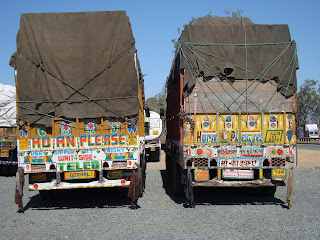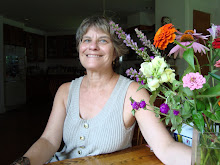
As most of you who are reading this know, our time in India was interrupted in mid-February by the sudden illness and death of my father, and the difficult trip back to the U.S. which that entailed. This isn't the time to write much about that, except to say that I think my Dad himself, who as he got into his eighties feared nothing more than a long, lingering illness, would have been pleased with the way it happened: while healthy and still playing golf three times a week, he entered the hospital for a minor adjustment to his pacemaker, but went into congestive heart failure and passed away within a week. The good news is that despite being so far away, I was able to get back in time to spend his final day with him while he was still conscious and able to communicate; I arrived in Florida, where he was hospitalized, on February 20, and he passed away on the morning of the 21st. Tova and her partner Harris, having a much shorter flight from New York, had already arrived the day before. So we were all able to be together with him on his last day. He died 12 days short of his ninetieth birthday.
Since I still had half the semester left to complete in India, I decided that I would like to return, and Bob agreed to come with me. It was a bit bewildering to settle in again after the intensity of the time in the U.S. -- not to mention just the physical toll from two trans-Atlantic flights and several flights in both the U.S. and India in the course of two weeks -- but actually returning to this green and peaceful campus was very calming, as was resuming the routine of classes and class preparation, which gave a familiar rhythm to my days. What had changed, however, was the degree of energy I had for activity beyond my teaching: I was happy to be at IRMA, and enjoyed my time in the classroom, but apart from that I was more likely to want to read a book or watch a movie on the one English-language movie cable channel than anything more ambitious. Perhaps not surprising. It's only now, almost a month after returning, that I feel I'm fully "waking up" from the not-unpleasant daze that I've been in. Which explains the long gap in this blog.
But, for the relatively short time remaining to me in India, I want to resume writing, which I enjoyed doing immensely in the first month and a half we were here. My course is now over -- my last class was this past Wednesday -- and tomorrow, Monday, afternoon my students will take their final exam. I think one hint that I was fully "awake" again was how much fun I had coming up with the questions for the exam -- something I don't get to do at exam-adverse Hampshire. Since one theme of the last part of the course was to investigate the pros and cons of biotechnology (including genetically modified crops) and the efforts that are being made internationally to regulate it; and many of the students here are familiar with the dairy industry, since Anand is the home of the huge and highly successful Amul dairy cooperative and the government's National Dairy Development Board; I decided to come up with a question about biotechnology and the dairy industry. I considered use of artificial growth hormones or applicability of GM techniques, but after a little Internet searching I discovered that there has actually been commercial cloning of prize cattle to serve as breeding stock for future generations -- so that the genetic advantages of the original prize cow can still be taken advantage of after its death. Who knew?? Anyway, that led to a question about cloning of prize milkers and selling their milk -- amazing to realize that what seem like "science fiction" possibilities to someone of my generation will be the actual choices of my students' generation. Not surprisingly, polls in many countries around the globe indicate that consumers don't like the idea of eating meat or drinking milk from cloned animals -- but then, how do consumers in the U.S. feel about the fact that almost all the packaged food in their supermarkets already incorporates genetically modified corn or soy? I doubt that most of them think about it at all, and if they were told, they'd be surprised. Over the last twenty years, GM crops have proliferated tremendously as consumers weren't really paying that much attention. Now, even in places that were much more GM-averse than the U.S. (which was always a booster at the government level), such as the EU and India and Africa, GM crops are mushrooming. As I tell my class, this is one of the hardest issues for me to reach a definitive personal opinion about. It's true that there's no hard evidence to suggest that these crops are harmful to human or ecological health -- and some to suggest they can actually be ecologically helpful, as for example by less pesticide use. And the alternative argument often used by some on the left -- that GM techniques allow multi-national corporations to take over the agricultural seed supply -- doesn't end up holding much water when you actually look at the facts (consider, for example, Ronald Herring's work on Bt cotton in India, see
http://www.agbioworld.org/pdf/CASHerringMonsanto2006.pdf ). Supposedly, as a sophisticated academic, I know better than to oppose something simply because of the gut feeling that "it just isn't natural" -- after all, a heart or kidney transplant isn't "natural" either, and I certainly don't oppose them. But I don't know. Although it's hard to pin down exactly what's wrong with GM food, if anything is -- and, given how rapidly the acreage planted in it is increasing all over the world, the question may be moot in any event -- I'm still left with an unsettled feeling in the pit of my stomach.
But you probably are wondering with some concern: "Did she re-start this blog in order to give us lectures on genetic modification?" -- and indeed I didn't. So let me end this entry with a forecast of what lies ahead for us in India until we return to the U.S., and then, perhaps next time, I'll pick up on whatever interesting events I've missed during this month of blog-silence.
As I said, my teaching here is completed, so once I grade my final exams, we are going to move on. On Thursday 3/26 we're flying to Varanasi, the holy city on the Ganges, where we're going to meet up with our good friends Jeanne and Wally from Miami -- he's a doctor who's come to India for several weeks of consultation with Indian colleagues in different cities, so they're combining work and vacation. Varanasi is the one place I visited on my previous trip to India that I really wanted to visit again, so we'll see how my impressions this time compare. I found the eerie spirituality of it -- people bobbing in the holy waters of the river, mist rising off the water, bodies burning on the cremation ghats, monkeys jumping around the walls of the temples -- completely captivating. The head of the Fulbright Program here in India, Adam Grotsky, recommended a hotel overlooking the river that was converted from an old Indian mansion (or haveli) that looks quite lovely on the Internet, and it sponsors concerts and art exhibits as well, so I'm looking forward to that. I remember the sitar concert that my friend Lydia and I attended when we were in Varanasi in 2001, which was quite amazing.
After Varanasi, we are flying to Chandigarh, where Wally has medical business, and Jeanne, Bob, and I will be tourists. Chandigarh was designed as a "new city" after independence with input from Le Corbusier -- and according to the guidebooks, it's very different from any other Indian city. We shall see how that strikes us. After that, Jeanne and Wally are going off to Rajasthan, and Bob and I are flying to Dharamsala, where I am going to be meeting with a small group of lawyers and administrators from the Supreme Justice Commission of the Tibetan Government-in-Exile. I am very excited about that. And then, on April 4, we fly back to Delhi for our flight that night to the U.S. -- so on the morning of April 5, we will land at Newark Airport. I am excited and sad, delighted and bemused, about going home -- even after 3 months, it feels in some weird way like
this is my home and I will have to get used to having that other, Northampton, one. But more on all of this soon -- now that I've started, I will be a regular blogger again.
















